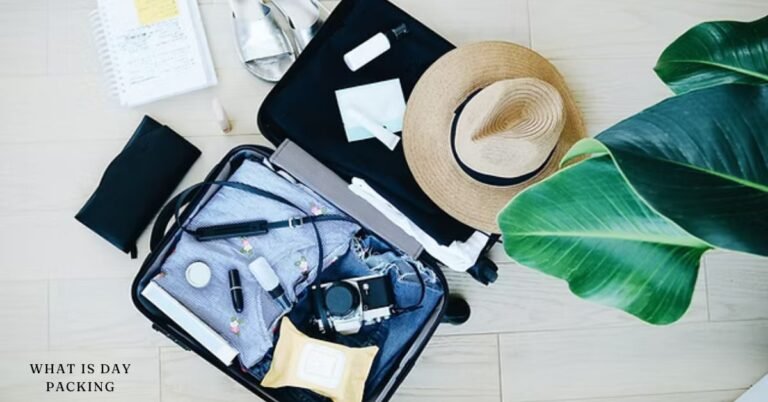Day packing is an essential skill for anyone who enjoys traveling, hiking, or simply spending a day away from home. Whether you’re heading out for a short hike, a city exploration, or a work-related trip, knowing what is day packing and how to do it effectively can make your experience smoother and stress-free. This article explores everything you need to know about day packing, including what to bring, how to pack efficiently, and practical tips to avoid overpacking.
Understanding What Is Day Packing
Definition and Importance of Day Packing
Day packing refers to the process of preparing and organizing essential items for a short trip, typically lasting less than 24 hours. Unlike traditional packing for long vacations, day packing requires a minimalist approach, ensuring you carry only the essentials without unnecessary weight.
The importance of day packing lies in its convenience and efficiency. Carrying a well-organized day pack allows you to move freely without feeling burdened. Whether you’re an outdoor adventurer, a frequent traveler, or someone who enjoys spontaneous outings, mastering day packing helps you stay prepared for any situation while maintaining comfort.
A well-packed day bag ensures you have everything needed without being overloaded. It also prevents last-minute stress by keeping your items neatly arranged and easily accessible. Additionally, a well-prepared pack can enhance your overall experience, whether you’re sightseeing, hiking, or attending business meetings.
Essential Items for a Well-Packed Day Bag
1. Choosing the Right Backpack
Before deciding what to pack, it’s essential to choose a suitable backpack. A good day pack should be lightweight, comfortable, and spacious enough to hold all your essentials without being too bulky.
Key Features to Consider:
- Size: A 10-30 liter backpack is ideal for most day trips.
- Compartments: Multiple pockets help in organizing items efficiently.
- Material: Water-resistant or waterproof fabric provides extra protection.
- Comfort: Padded shoulder straps and breathable back panels prevent discomfort.
2. Essential Items to Pack
Regardless of the nature of your trip, some items are universally essential for day packing:
- Water Bottle: Staying hydrated is crucial, especially for outdoor activities.
- Snacks or Light Meals: Energy bars, nuts, or sandwiches keep you fueled.
- First Aid Kit: Band-aids, pain relievers, and antiseptic wipes for emergencies.
- Weather Protection: A light rain jacket, sunscreen, and sunglasses.
- Navigation Tools: A physical map, GPS device, or a charged smartphone with maps.
- Power Bank: Ensures your phone and gadgets stay charged throughout the day.
- Multipurpose Tools: A Swiss Army knife or a compact multi-tool can be handy.
- Personal Hygiene Items: Hand sanitizer, tissues, and lip balm.
Packing strategically with these essentials ensures a smoother and more enjoyable trip.
Step-by-Step Guide to Efficient Day Packing
1. Make a Packing List
Creating a checklist helps you stay organized and ensures you don’t forget anything. Write down your essentials based on the trip type and expected weather conditions.
2. Use Packing Cubes or Zip Bags
Organizing smaller items in zip bags or packing cubes helps save space and prevents clutter inside your bag.
3. Pack in Layers
Place heavier items at the bottom and lighter essentials on top for easy access.
4. Keep Essentials Within Reach
Store frequently used items like your phone, wallet, and snacks in easily accessible pockets.
5. Avoid Overpacking
Stick to the essentials. Packing too much can make your bag uncomfortable to carry for long hours.
Day Packing for Different Activities
1. Hiking and Outdoor Adventures
When packing for a hike or nature excursion, prioritize comfort and safety.
Essentials for a Hiking Day Pack:
- Lightweight backpack with chest and waist straps for support.
- Plenty of water and snacks for sustained energy.
- Emergency items like a flashlight, whistle, and first aid kit.
- Extra clothing layers for temperature changes.
2. Urban Exploration and City Travel
If you’re exploring a new city for a day, your packing strategy should focus on convenience.
City Day Packing Must-Haves:
- Small crossbody or anti-theft bag for security.
- Reusable shopping bag for souvenirs or purchases.
- Comfortable walking shoes and a light jacket.
- Notebook or travel journal for jotting down experiences.
3. Work or Business Day Trips
For professionals traveling for work, an organized and professional-looking bag is key.
Business Day Packing Checklist:
- Laptop and charger.
- Notepad and pens for meetings.
- Business cards for networking.
- A compact grooming kit to stay fresh throughout the day.
Each type of day trip requires specific packing considerations to ensure you have what you need without carrying unnecessary weight.
Comparison Chart: Day Packing vs. Regular Travel Packing
| Feature | Day Packing | Regular Travel Packing |
|---|---|---|
| Trip Duration | Less than 24 hours | Several days to weeks |
| Bag Size | 10-30L backpack | 50L+ suitcase/backpack |
| Number of Items | Minimal essentials | Clothes, toiletries, extras |
| Packing Style | Lightweight and efficient | More detailed and structured |
| Mobility | High, easy to carry | Lower, often bulky |
| Best For | Hiking, city trips, work, events | Long vacations, multi-day trips |
This comparison shows how what is day packing differs from regular packing and why it’s ideal for short trips requiring mobility and efficiency.
Pro Tips for a Stress-Free Day Packing Experience
1. Pack the Night Before
Rushing in the morning can lead to forgetting essentials. Preparing ahead of time ensures a smooth start.
2. Consider the Weather Forecast
Check the weather before leaving and pack accordingly. If rain is expected, bring a compact umbrella or rain poncho.
3. Travel Light, but Smart
Only bring what you truly need. Every extra item adds weight and reduces comfort.
4. Secure Valuables
Use anti-theft bags or hidden pouches for cash, cards, and passports to avoid theft.
5. Choose Versatile Clothing
Opt for lightweight and breathable clothing that can be layered if needed.
By following these pro tips, you can ensure a hassle-free and enjoyable day trip experience.
Conclusion: Mastering the Art of Day Packing
Understanding what is day packing and how to do it efficiently can significantly enhance your travel and outdoor experiences. By packing light, staying organized, and tailoring your items to the specific trip type, you can enjoy maximum convenience without the burden of excess weight.
Whether you’re exploring a new city, embarking on a hiking adventure, or heading out for a work trip, a well-packed day bag ensures you’re prepared for whatever comes your way. By implementing the tips and strategies discussed, you can confidently master the art of day packing and enjoy stress-free travel every time.

